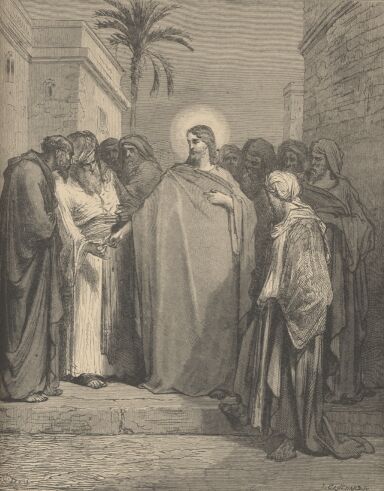The views expressed in our content reflect individual perspectives and do not represent the authoritative views of the Baha'i Faith.
Night had fallen upon the holy city of Jerusalem. Somewhere in the city, Jesus Christ sat with his disciples around a Passover table. The disciples all knew that Christ’s earthly mission was nearing its end. Jesus had just foretold a betrayal by one of his inner circle, and Judas had fled. In this ominous, foreboding setting Jesus gave a private discourse to his disciples—one that unlocks some of the Bible’s most mysterious themes.
This discourse, recorded in the Gospel of John, is sometimes known as Jesus’s ‘Farewell Discourse.’ At first glance many of its teachings are paradoxical. When the disciple Philip pled, “Lord, shew us the Father, and it sufficeth us,” Jesus responded:
Have I been so long time with you, and dost thou not know me, Philip? he that hath seen me hath seen the Father… Believest thou not that I am in the Father, and the Father in me? the words that I say unto you I speak not from myself: but the Father abiding in me doeth his works… – John 14:8-10.
The disciples already knew that “No man hath seen God at any time,” and “Ye have neither heard his voice…nor seen his form” – John 1:18; 5:37. Yet seeing is believing, as the old saying goes, and in the face of mounting uncertainties, Philip wanted the certainty of sight. Jesus told him that what he needed to see was right in front of him, and had been all along. By recognizing Jesus, Philip had indeed seen the Father, the same God “dwelling in light unapproachable; whom no man hath seen, nor can see” – 1 Tim. 6:16.
“Sight” is a recurring theme in the Farewell Discourse, and the initial exchange between Philip and Jesus sheds light on further enigmas. Although promising his own return, Jesus prophesied that “the world beholdeth me no more” – John 14:19, and made the seemingly contradictory statement, “A little while, and ye behold me no more; and again a little while, and ye shall see me” – John 16:16. How could Jesus’s followers “see” him again when, after his earthly mission, they would see him no more?
Another central element of the Discourse offers a clue—the coming of a mysterious figure whom Jesus calls “the Comforter,” “the Paraclete,” or the “Spirit of truth:”
Howbeit when he, the Spirit of truth, is come, he shall guide you into all the truth: for he shall not speak from himself; but what things soever he shall hear, these shall he speak: and he shall declare unto you the things that are to come. – John 16:13.
According to Jesus, “he that hath seen me hath seen the Father.” In the same way it follows that one who has seen the Comforter has also seen Christ. In the Farewell Discourse we learn that the Comforter is sent by both the Father and Christ (John 15:26; 16:7,12-16), and speaks only as divinely guided. This resolves the paradox of how Christ’s followers can both see him again, and see him no more.
In fact, Jesus introduces the Comforter in connection with the promise of his own return:
And I will pray the Father, and he shall give you another Comforter, that he may be with you for ever, even the Spirit of truth: whom the world cannot receive; for it beholdeth him not, neither knoweth him: ye know him; for he abideth with you, and shall be in you. I will not leave you desolate: I come unto you. Yet a little while, and the world beholdeth me no more; but ye behold me: because I live, ye shall live also. In that day ye shall know that I am in my Father, and ye in me, and I in you.—John 14:16-18, 20.
Here the arrival of the Comforter and the return of Christ serve as different descriptions of the exact same event. Otherwise, the passage presents two permanent solutions to the same problem—the disciples’ aloneness after Christ’s departure. Jesus’s teaching that “he that hath seen me hath seen the Father” reveals how the arrival of the “other” Comforter can be the return of the first Comforter—Jesus himself.
 This stunning implication in Jesus’s Farewell Discourse sheds light on several mysteries surrounding the second coming of Jesus—why he comes with “a new name” (Revelation 3:12); how it is that he returns “as a thief in the night” (1 Thess. 5:2); and what it means when we read that Jesus’s own existence is no longer physical—“The last Adam [Jesus] became a life-giving spirit” (1 Cor. 15:45; 1 Peter 3:18).
This stunning implication in Jesus’s Farewell Discourse sheds light on several mysteries surrounding the second coming of Jesus—why he comes with “a new name” (Revelation 3:12); how it is that he returns “as a thief in the night” (1 Thess. 5:2); and what it means when we read that Jesus’s own existence is no longer physical—“The last Adam [Jesus] became a life-giving spirit” (1 Cor. 15:45; 1 Peter 3:18).
The similarity between Christ and the Comforter doesn’t end with the fact that both are sent from God. As we see above, Jesus described the promised messenger as “another Comforter” (Greek, allon paraklēton), where the Greek word for “another,” allos, means another of the same kind (see Vine’s Expository Dictionary of New Testament Words, p. 451). In his letter, the disciple John reveals that the first Comforter was Christ himself—1 John 2:1.
Jesus was the Word of God made flesh—both divine and human (John 1:14). Christians generally understand Jesus’s statements such as “I spake not from myself” (John 12:49) or “the Son can do nothing of himself” (John 5:19) to refer to his human station. Clearly the divine Word of God itself doesn’t need to be told what to say or do!
Likewise, the human nature of the Comforter comes through in Jesus’s words, “he shall not speak from himself; but what things soever he shall hear, these shall he speak” (John 16:13). Although named “Holy Spirit” and “Spirit of truth”, the Comforter will thus possess a servant nature (compare Philippians 2:7) that stands in need of God’s guidance. Like Jesus himself, he is a fulfillment of God’s promise of the True Prophet in Deuteronomy 18:18—“I will put my words in his mouth, and he shall speak unto them all that I shall command him.”
In light of this, the following words of Baha’u’llah, the founder and prophet of the Baha’i Faith, commend themselves to our close attention:
Announce thou unto the priests: Lo! He Who is the Ruler is come. Step out from behind the veil in the name of thy Lord, He Who layeth low the necks of all men. Proclaim then unto all mankind the glad-tidings of this mighty, this glorious Revelation. Verily, He Who is the Spirit of Truth is come to guide you unto all truth. He speaketh not as prompted by His own self, but as bidden by Him Who is the All-Knowing, the All-Wise.— Tablets of Baha’u’llah, p. 12.
Millions around the world recognize the fulfillment of Christ’s teachings in the sterling life and astounding writings of Baha’u’llah—who lived the message that God, the merciful Father, has now empowered humanity to unite as one in pursuit of the supreme ideal, “Thy will be done on earth as it is in heaven.” Every follower of Jesus is invited to impartially consider his claim.
















Comments
Sign in or create an account
Continue with Googleor